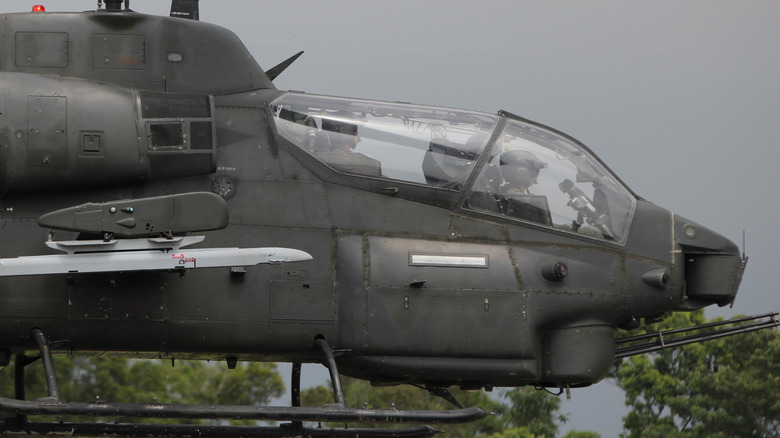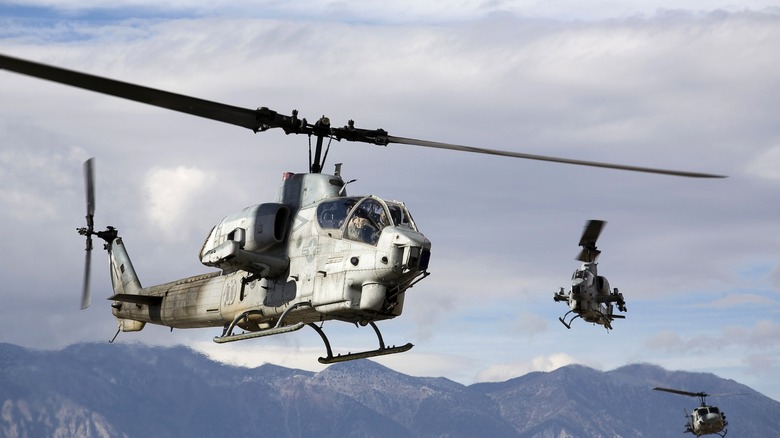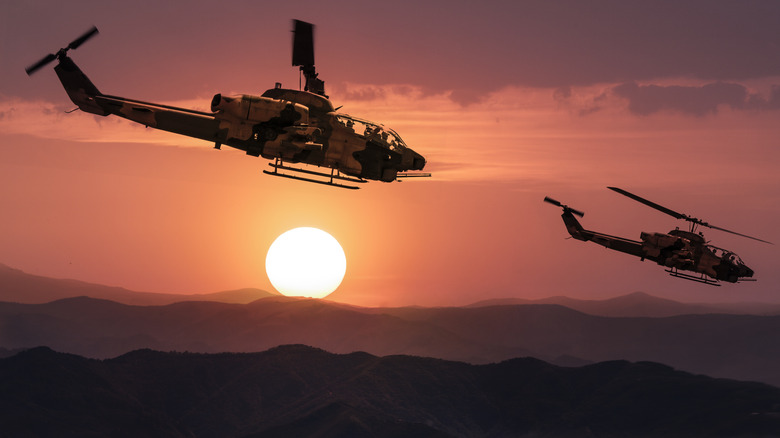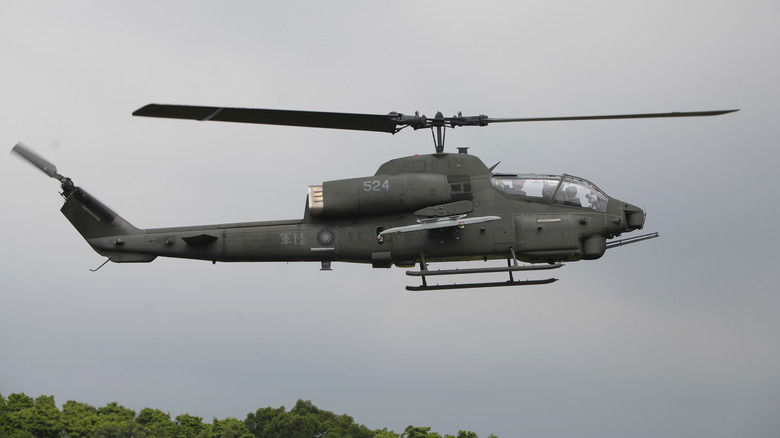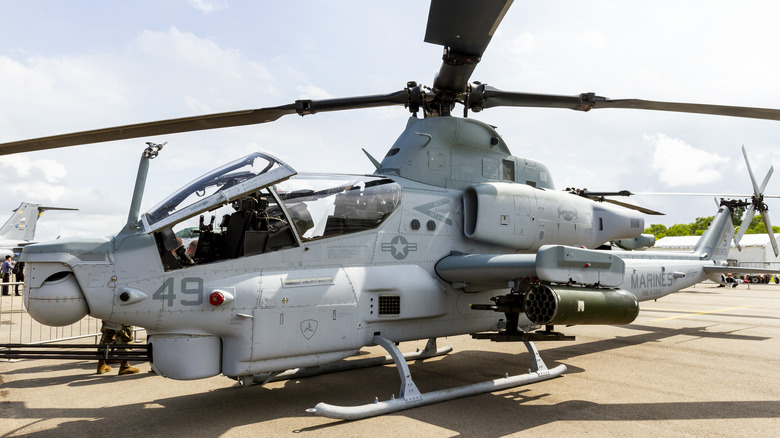Everything To Know About The Bell AH-1 SuperCobra Attack Helicopter
The fighter jet has been constantly transforming and advancing since the very first aircraft of its type, the Messerschmitt Me 262, but it took a bit longer for a true attack helicopter to arrive. In that arena, the Bell AH-1W SuperCobra would be a powerhouse in the U.S. arsenal for decades, and it was used by the Marine Corps.
The Bell AH-1's journey from Cobra to SuperCobra began with the limitations of the UH-1 Huey, an iconic helicopter that, while used a lot in Vietnam, wasn't really up to the new task as an attack option. Bell Helicopters' Mike Folse is quoted by Smithsonian Magazine as remembering that, during the conflict, the Hueys "could barely keep up with the troop transports they were supposed to protect." A less-than-auspicious start. What was plainly needed by the US military, then, was a helicopter with two crucial qualities: Speed and power.
This way of thinking quickly led from the humble Huey to the formidable AH-1, which would, in turn, give way to the very sophisticated AH-1W, or SuperCobra. Here's a closer look at Huey's shortcomings, the resultant rise of the Cobra and SuperCobra, and the latter's capacities and legacy.
How did the original Bell AH-1 Cobra come about?
Helicopters, with their unique maneuverability, have a lot of military utility as transport vehicles. The Bell UH-1 Iroquois, or Huey, was used in this capacity by the United States in the Vietnam War, but inevitably, its value and largely defenseless nature combined to make it a premium target. In an effort to somewhat circumvent this, the Huey did boast machine guns, but rather than being designed for combat first, they were really more of a last resort manner of warding foes away.
More supportive aircraft required better protection in order to be able to do their vital work in relative safety. A call for an Advanced Aerial Fire Support System was issued to address this, seeking an attack helicopter capable of reaching up to 250 mph. Mike Folse of Bell Helicopters devised a design to try and fit that bill, a threatening new take on the already-in-service Huey family dubbed Model 209. This helicopter would become the mighty Cobra.
The specs and weaponry of the Bell AH-1 Cobra
Ultimately, a ship that happens to have guns and a gunship are two very different things. Cursory weapons added out of necessity probably won't be practical to use, and an arsenal, however potent, won't be of much use either if an aircraft isn't speedy and capable enough to wield it effectively. As such, the Cobra, which first saw combat in 1967 and 68, had to combine engine power and firepower to be a success.
The Cobra's arsenal included Folding Fin Aerial Rockets and an M65 TOW (tube-launched, optically tracked, wire-guided), a sophisticated weapon designed to deploy missiles that could effectively penetrate armor. Along with a more conventional heavy gun, this meant that the helicopter boasted the versatility to threaten targets in the air and on land, a unique and potent new weapon as it was intended to be. It was powered by a Lycoming T53-L-703, which allowed it to reach a maximum of 172 mph with a ceiling of around 12,400 feet.
The Cobra would also be a big part of future conflicts, including Operation Just Cause. The U.S. Army continued to use the original model until its retirement from the branch in March of 1999. There was much more to come from the Cobra family, though.
From SeaCobra to SuperCobra
Such a solid foundation resulted in the first Cobra being further adopted, adapted, and improved upon. Perhaps the most significant addition to the family was the AH-1J or SeaCobra. This model, adapted for use by the Marine Corps, was equipped with two Pratt & Whitney T400-CPs, which further boosted its speed up to 207 mph.
The AH-1J contributed to high-profile operations throughout the 1970s, seeing the United States out of the Vietnam War and beyond. 1978 marked the introduction of the AH-1T, a model that was a further step above with improved Model 309 engines and transmission. The idea seemed to be for the most potent and capable AH-1 yet, but something even greater would arrive eight years later: The SuperCobra.
This model, named the AH-1W, first entered service with the Marine Corps in 1986. It embraced the common concept that two engines are better than one. Specifically, it was equipped with two General Electric T700-GE-401 engines, which gave it a range of just under 300 miles and the power to hit 169 mph. Needless to say, though, one of the most important aspects of the SuperCobra's development was the broadening of its arsenal of weapons. It was expanded to include the likes of Sidewinder and Hellfire missiles, thereby giving the helicopter further options against more difficult armored targets.
The combat history of the SuperCobra and the rise of the Viper
In Operation Desert Storm, the model demonstrated its remarkable offensive prowess: A total of 219 targeted armored vehicles and fortified sites were destroyed by just 48 deployed SuperCobras. Operation Enduring Freedom and Operation Iraqi Freedom would also see Cobra family involvement into the early 2000s.
As mighty a force as the SuperCobra was, time and the relentless march of technology waits for no attack helicopter. As the SuperCobra was an advanced take on the Cobra, so the SuperCobra would be replaced by a more fearsome serpent: The AH-1Z Viper.
It wasn't until 2020 that the SuperCobras made their final flights, ceasing service with the Marine Corps (even the mightiest models like the Black Hawk are replaced) that October. It bowed out in favor of the further advanced AH-1Z Viper, equipped with two T700-GE-401C engines. Capable of hitting 250 mph, and with a glass cockpit and improved landing gear, the performance and usability of the model are dramatically improved. So, too, is its weapons arsenal, now featuring AIM-9 missiles and a sophisticated Target Sight System paired with the Optimized TopOwl Helmet for the pilots.
All in all, the Viper is a potent and practical weapon, well equipped to handle traditional issues for helicopters, like difficult weather conditions. Deadly, versatile, and faster than ever, there could be no more fitting model to take up the SuperCobra's legacy.
